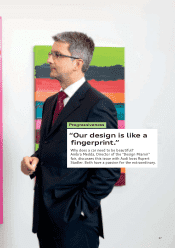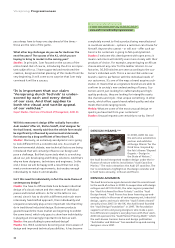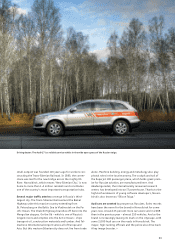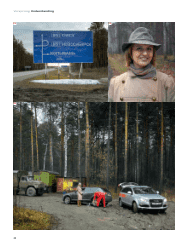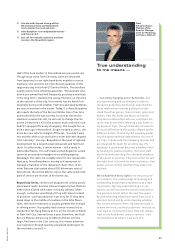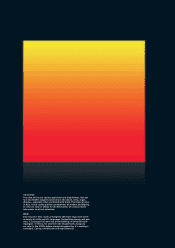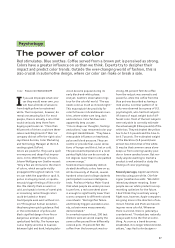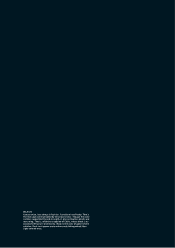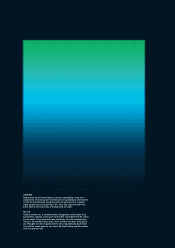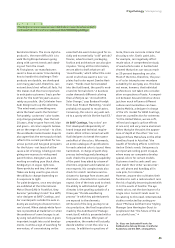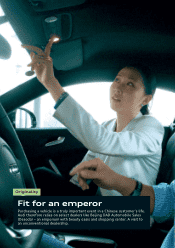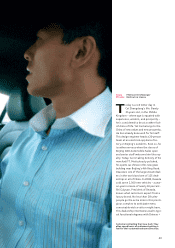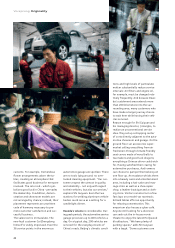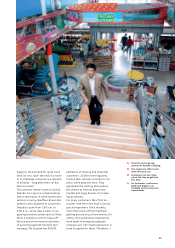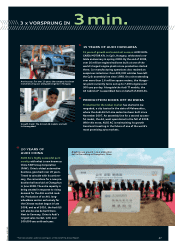Audi 2008 Annual Report Download - page 41
Download and view the complete annual report
Please find page 41 of the 2008 Audi annual report below. You can navigate through the pages in the report by either clicking on the pages listed below, or by using the keyword search tool below to find specific information within the annual report.
37
f you ask 10 people what color
car they would never own, you
will hear all kinds of answers;
from bright yellow to restrained
white. Their responses, however, do
reveal one amazing fact: For most
people, there is actually a color that
would seriously keep them from
buying a particular car. “More than
40 percent of drivers could see them-
selves switching brands if their car
company did not offer the right color,”
says Karen Surcina, Color Marketing
and Technology Manager at the U.S.
coatings giant DuPont.
Colors are powerful. They cast a spell
on everyone and shape first impres-
sions. In his 1810 Theory of Colors,
Johann Wolfgang von Goethe mused:
“Only a few are immune to the charm
of colors, which are quite visibly
propagated throughout nature.” Col-
ors can whet the appetite or spoil it,
put us in a buying mood, or sponta-
neously trigger feelings of like or dis-
like. We classify them as warm or
cold, and speak in terms of sweet pink
or screaming red as though colors
could be tasted or heard.
Could people even exist without col-
ors? Throughout human evolution,
they have given quick guidance: Red
or the combination of yellow and
black signified danger from fire or
dangerous animals, while green
symbolized fertility. The human eye
is also highly sensitive to nuances
between light and dark, helping tele-
vision become popular during its
early black-and-white phase.
And yet, Goethe’s observation rings
true for the colorful world: “The eye
needs color as much as it needs light.”
This may explain the proclivity for
colorful houses in Scandinavian coun-
tries, where winters are long, dark
and colorless. Colorful diversions
apparently keep us sane.
“Colors shape our thoughts, feelings
and actions,” says renowned color psy-
chologist Harald Braem. “They have a
measurable influence on heartbeat,
pulse and blood pressure. They can
soothe or provoke fear, cause sensa-
tions of hunger and thirst, hot or cold.
The perceived temperature in a room
painted light blue can be as much as
ten degrees lower than in one painted
a warm orange.”
Scientists have repeatedly demon-
strated the effects colors have on us.
At the University of Munich, several
hundred school and college students
participated in various intelligence
tests. Professor Markus Maier found
that when people are under pressure
to perform, a red coversheet alone
is enough to significantly lower their
scores compared to different-colored
coversheets: “Red signifies failure
and thereby triggers avoidance anxi-
ety, as brain wave measurements
demonstrated.”
In a market research test, 200 test
drinkers were all served exactly the
same coffee poured from differently
colored pots. 73 percent felt the
coffee from the brown pot was too
The power of color
Red stimulates. Blue soothes. Coffee served from a brown pot is perceived as strong.
Colors have a greater influence on us than we think. Experts try to decipher their
impact and predict color trends. Outside the ever-changing world of fashion, this is
also crucial in automotive design, where car color can make or break a sale.
P
P
s
s
y
y
c
c
h
h
o
o
l
l
o
o
g
g
y
y
strong, 84 percent felt the coffee
from the red pot was aromatic and
powerful, while the coffee from the
blue pot was described as having a
mild aroma. A similar pattern of re-
sults was observed by a group of U.S.
psychologists, who had test subjects
lift boxes of equal weight but of dif-
ferent color. Most of the test subjects
were only able to correctly estimate
the actual weight (three pounds) of the
white box. They estimated the yellow
box to be 3.5 pounds and the blue to
be 4.7 pounds. The estimated weight
of the black box (5.8 pounds) was
almost two times that of the white.
It may be that common sense alone
keeps us from coloring laundry pow-
der or lemon candies brown. But nor-
mally anyone wanting to market a
product is well advised to study the
findings of color psychology.
Several years ago, Apple launched a
trend by using pure white. Chief de-
signer Jonathan Ive adds: “We didn’t
intend any deeper meaning. Some
people see our white products as rep-
resenting optimism for the future.
I don’t think they’re entirely wrong.”
Right now, however, Apple computers
are going more in the direction of alu-
minum finishes and iPods are becom-
ing ever more colorful. Wherever
there is a trend, there is generally a
countertrend. “Trendsetters naturally
always want to be the first at some-
thing. As soon as a trend becomes
established, it no longer interests trend-
setters,” says Audi color designer
Copy Klaus von Seckendorff
I


